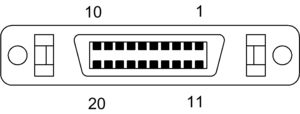VESA Digital Flat Panel
 From Wikipedia the free encyclopedia
From Wikipedia the free encyclopedia
This article needs additional citations for verification. (March 2012) |
| Type | Digital video connector | ||
|---|---|---|---|
| Production history | |||
| Designer | Video Electronics Standards Association | ||
| Designed | February 14, 1999 | ||
| Superseded | VGA connector | ||
| Superseded by | Digital Visual Interface | ||
| General specifications | |||
| Pins | 20 | ||
| Data | |||
| Data signal | PanelLink protocol Transition Minimized Differential Signaling | ||
| Width | 3 bits plus clock | ||
| Max. devices | 1 | ||
| Protocol | PanelLink (Serial) | ||
| Pinout | |||
 | |||
| Pin 1 | TMDS data 1 + | ||
| Pin 2 | TMDS data 1 – | ||
| Pin 3 | GND | ||
| Pin 4 | GND | ||
| Pin 5 | TMDS data C + | ||
| Pin 6 | TMDS data C – | ||
| Pin 7 | GND | ||
| Pin 8 | + 5V | ||
| Pin 9 | Reserved | ||
| Pin 10 | Reserved | ||
| Pin 11 | TMDS data 2 + | ||
| Pin 12 | TMDS data 2 – | ||
| Pin 13 | GND | ||
| Pin 14 | GND | ||
| Pin 15 | TMDS data 0 + | ||
| Pin 16 | TMDS data 0 – | ||
| Pin 17 | Reserved | ||
| Pin 18 | Reserved | ||
| Pin 19 | DDC data | ||
| Pin 20 | DDC clock | ||
The VESA Digital Flat Panel (DFP) interface standard specifies a video connector and digital TMDS signaling for flat-panel displays.[1] It features 20 pins and uses the PanelLink protocol; the standard is based on the preceding VESA Plug and Display (P&D) standard, ratified in 1997. Unlike the later, electrically-compatible Digital Visual Interface (DVI, 1999), DFP never achieved widespread implementation.
History[edit]
P&D combined analog and digital video with data over USB and FireWire to reduce cable clutter, but the feature creep resulted in an unpopular, expensive connector.[2]: 4 Compaq described DFP as a "transition" step between the analog VGA connector and P&D: DFP was designed by a consortium including Compaq, Hewlett-Packard, and ATI Technologies as a smaller, simpler connector, dropping support for analog video and data in favor of transmitting exclusively digital video signals.[1]
The connector was used by displays such as the Compaq Presario FP400, FP500, FP700, Fp720, 5204, and 5280. It was offered on graphics cards such as the Xpert LCD,[3] and Rage LT Pro by ATI Technologies, and the Oxygen GVX1[4] by 3Dlabs.
Design[edit]
DFP is compatible electrically with P&D (and by extension, DVI); DFP uses the Display Data Channel (DDC) standard level DDC2B for operation and the Extended Display Identification Data (EDID) protocol to identify the display to the host.[5]: §1.2 Like the preceding P&D, DFP uses the PanelLink TMDS protocol developed by Silicon Image for digital video signals.[2]
The DFP standard specifies a 20-pin mini D ribbon connector;[5]: §3.3 however, as the signal protocols are identical, DFP connectors generally are compatible with devices equipped with a DVI interface by using a passive adaptor.
All DFP-compliant devices are required to support resolutions of 640×400, 720×400, and 640×480 (each at a refresh rate of 60Hz) as a minimum level of interoperability, although the resulting display may not necessarily be centered or scaled.[5]: §3.7
DFP was superseded by DVI because DFP, like P&D, is limited to a single-link TMDS signal. In contrast, DVI is capable of higher maximum resolutions because it supports a dual-link TMDS signal; in addition, DVI also supports analog video, which makes the VGA connector redundant.[2]
- male DFP connector
- female DFP connector
- DVI-DFP adaptor
References[edit]
- ^ a b Manchester, Gary (1999). The VESA Digital Flat Panel (DFP) Standard: A White Paper (PDF) (Report). VESA Marketing Committee. Archived from the original (PDF) on January 12, 2016.
- ^ a b c Digital Visual Interface & TMDS Extensions (PDF) (Report). Silicon Image. October 2004. Retrieved 31 January 2023.
- ^ "XPERT LCD". Archived from the original on 2003-07-21.
- ^ "Oxygen GVX1 AGP specs sheet" (PDF).
- ^ a b c "VESA Digital Flat Panel (DFP) Standard, Version 1" (PDF). Video Electronics Standards Association. February 14, 1999. Archived from the original (PDF) on June 2, 2001.
External links[edit]


